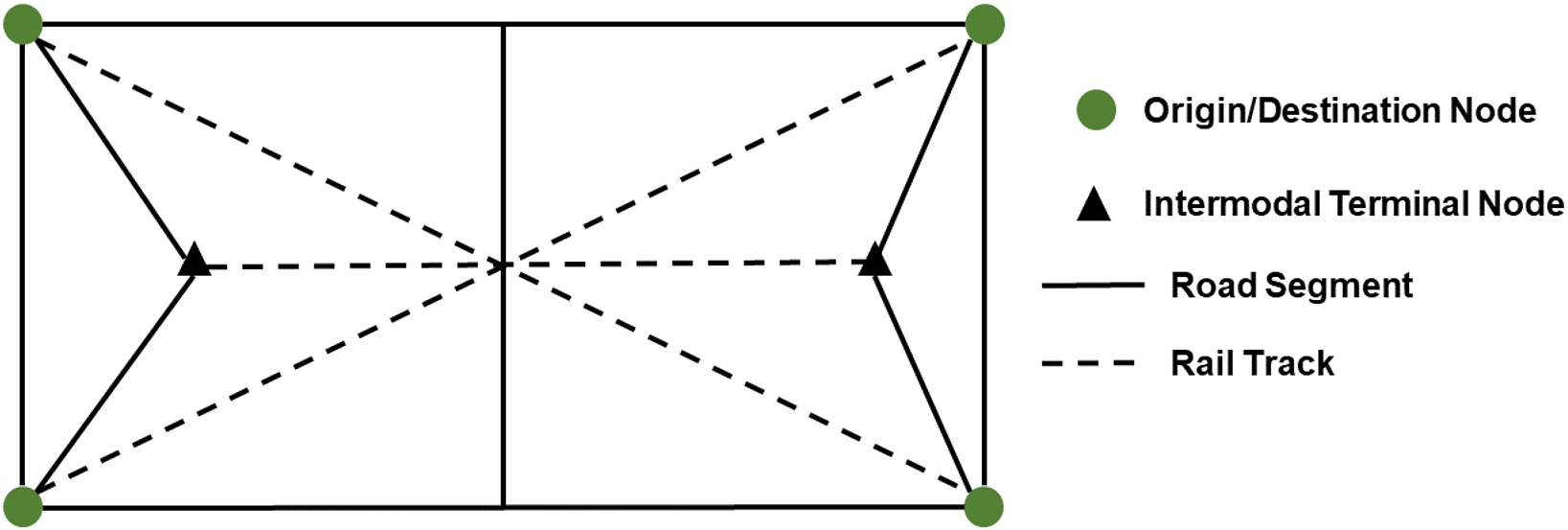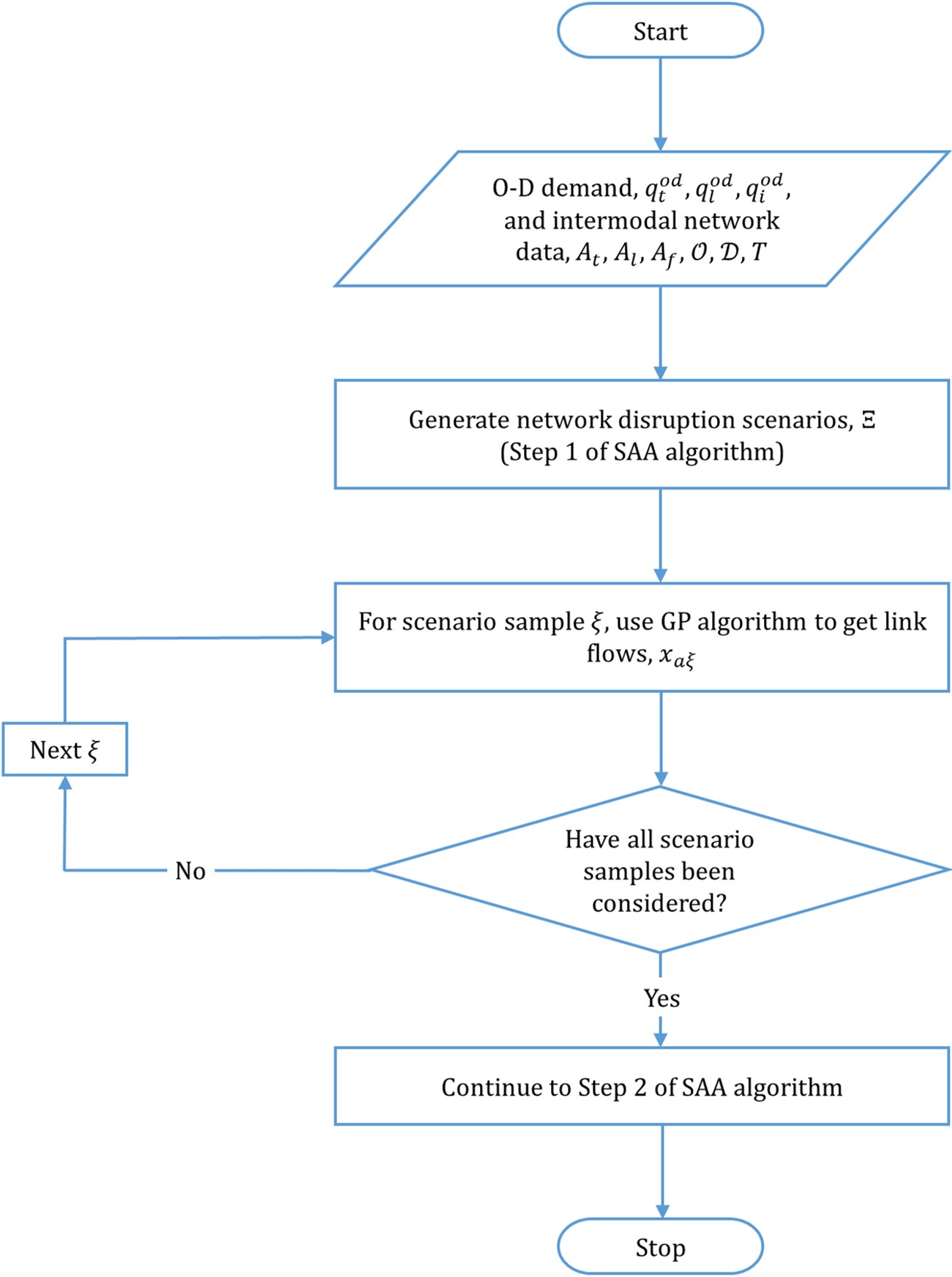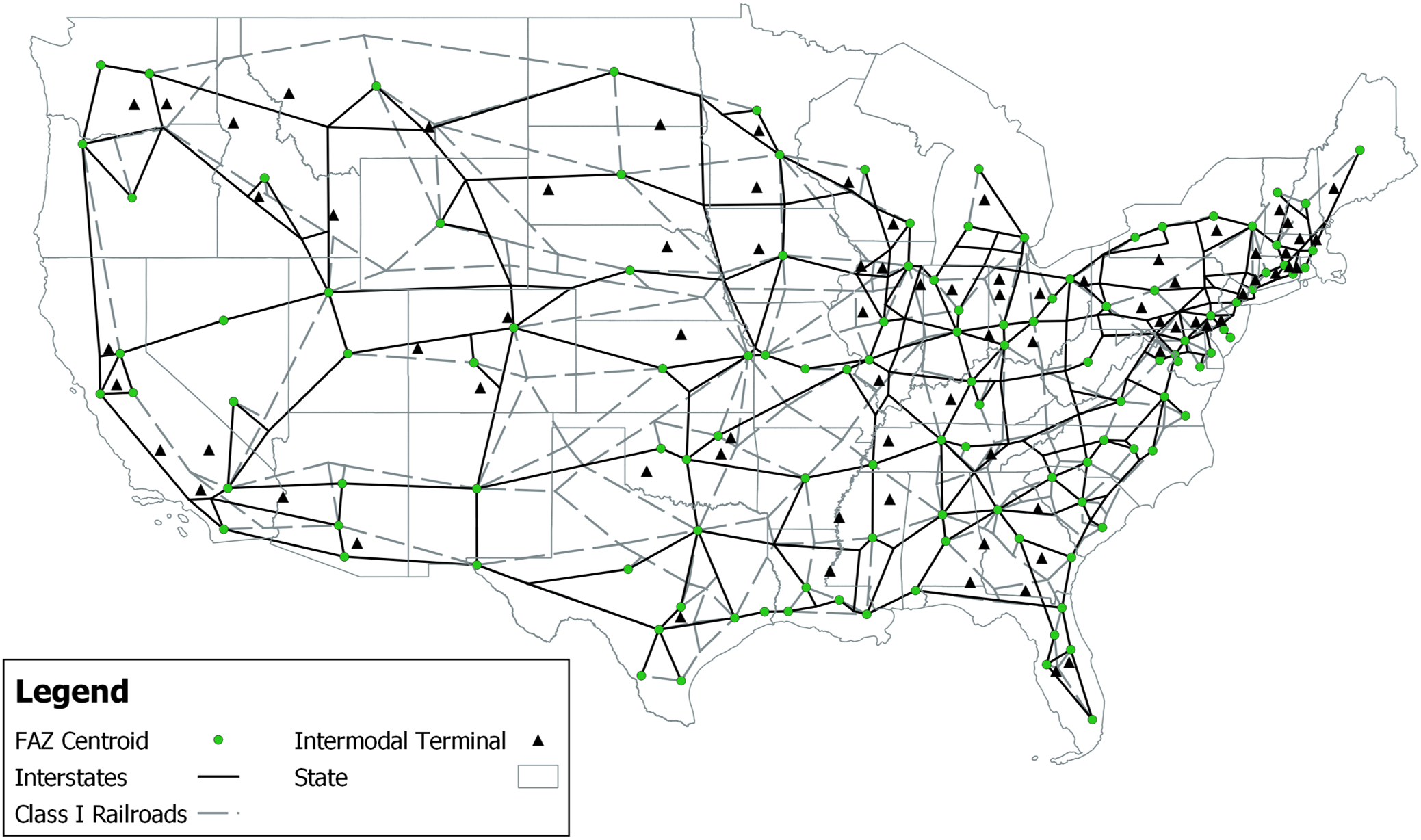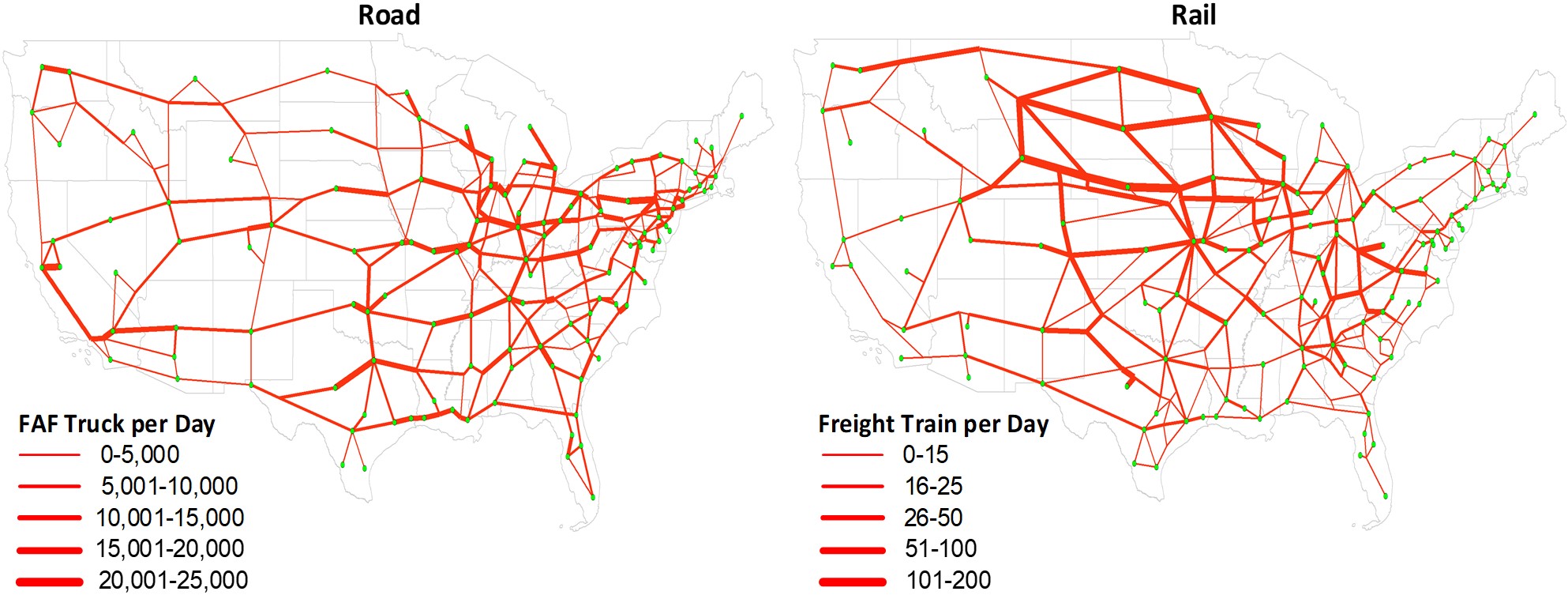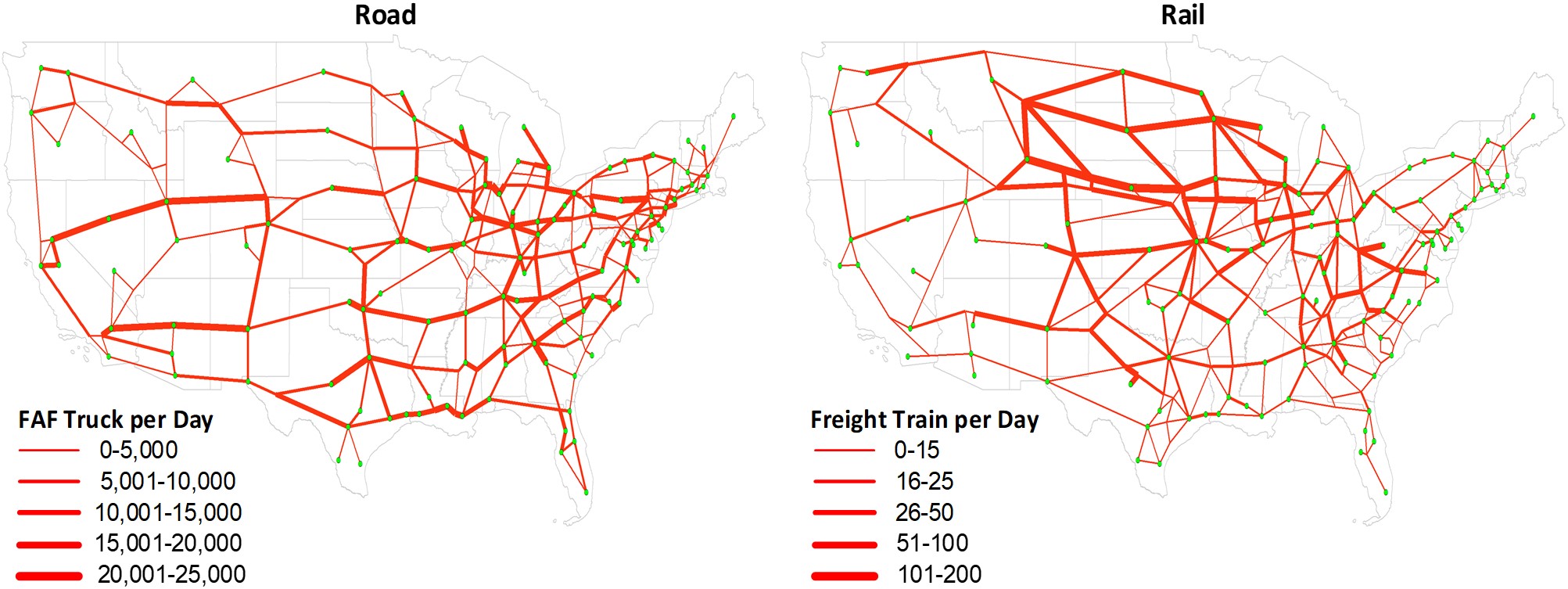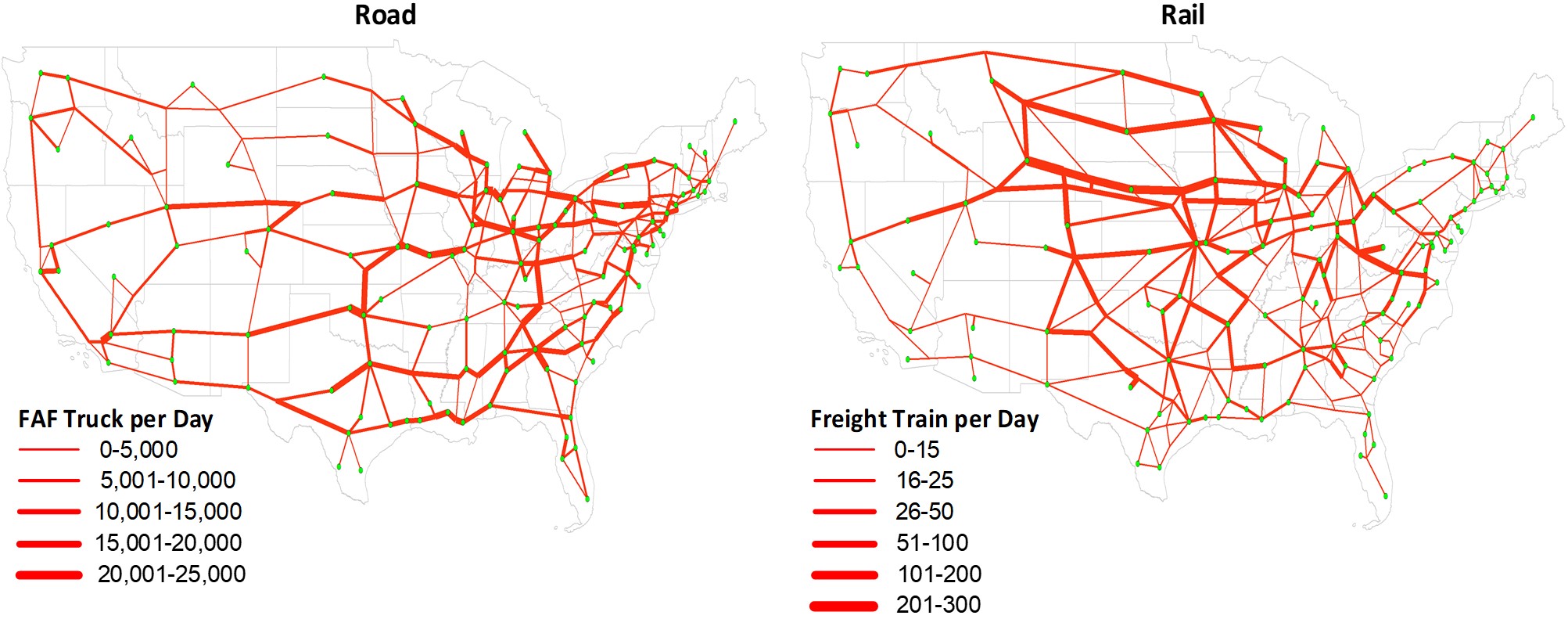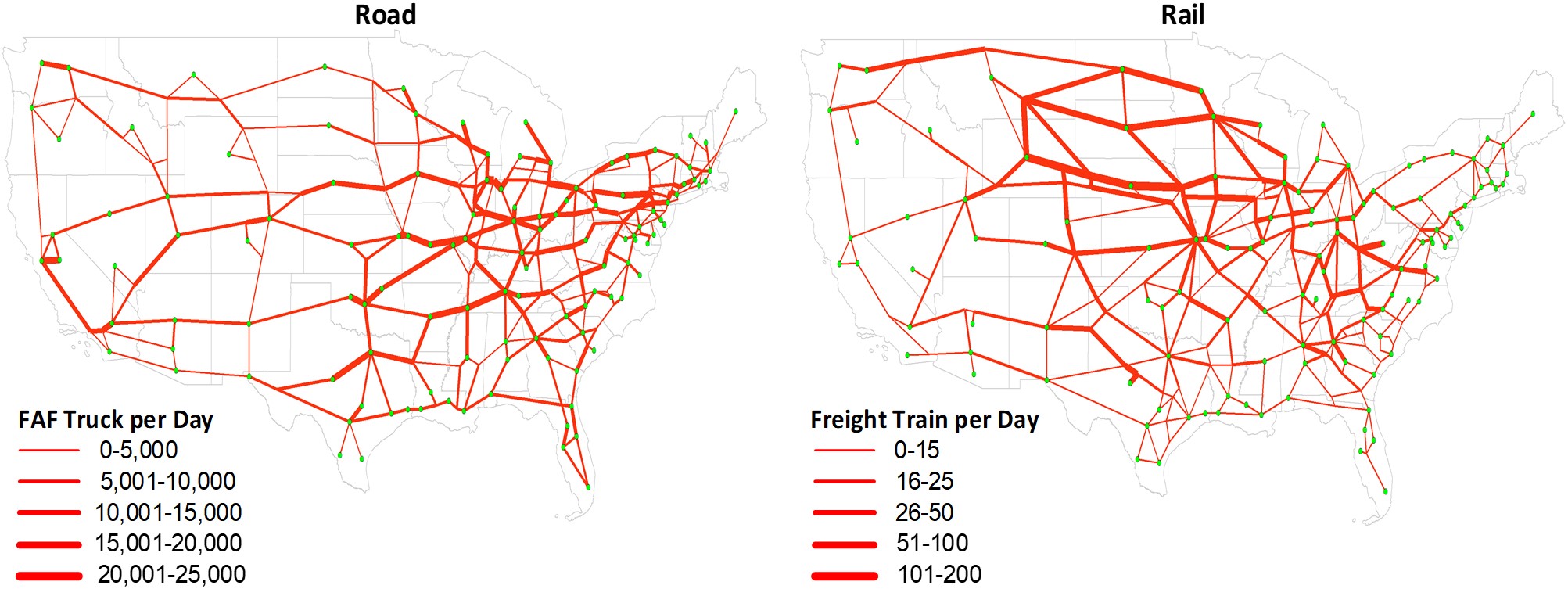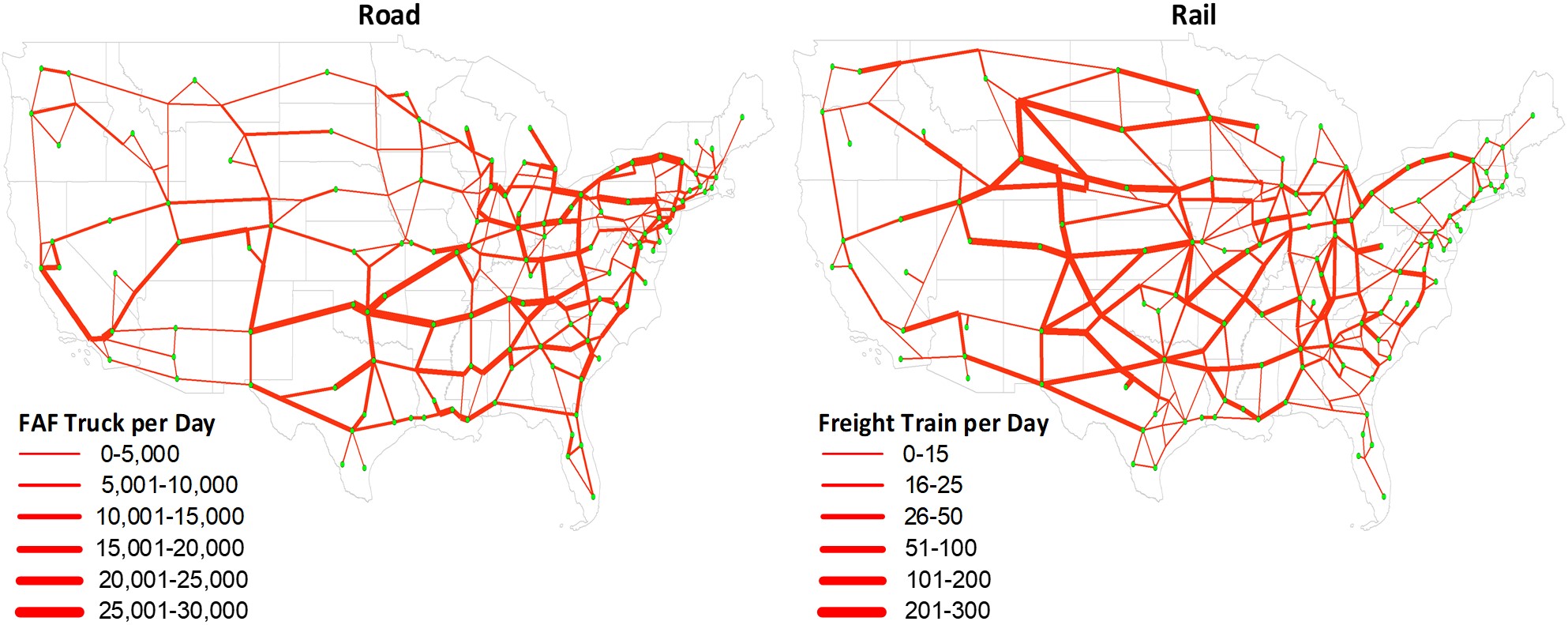Article Peer-Reviewed
Assignment of Freight Traffic in a Large-scale Intermodal Network under Uncertainty
1
National Transportation Research Center, Oak Ridge National Laboratory, 1 Bethel Valley Road, Oak Ridge, TN 37830, USA
2
Department of Civil and Environmental Engineering, University of Nebraska-Lincoln, 2200 Vine St, 262D, Lincoln, NE 68583-0851, USA
3
South Carolina Department of Transportation, 955 Park St, Columbia, SC 29202, USA
*
For correspondence.
Academic Editor:
 Maxim A. Dulebenets
Maxim A. Dulebenets
Received: 15 November 2023 Accepted: 21 December 2023 Published: 28 December 2023
Abstract
This paper presents a methodology for freight traffic assignment in a large-scale road-rail intermodal network under uncertainty. Network uncertainties caused by natural disasters have dramatically increased in recent years. Several of these disasters (e.g., Hurricane Sandy, Mississippi River Flooding, and Hurricane Harvey) severely disrupted the U.S. freight transportation network, and consequently, the supply chain. To account for these network uncertainties, a stochastic freight traffic assignment model is formulated. An algorithmic framework, involving the sample average approximation and gradient projection algorithm, is proposed to solve this challenging problem. The developed methodology is tested on the U.S. intermodal network with freight flow data from the Freight Analysis Framework. The experiments consider three types of natural disasters that have different risks and impacts on transportation networks: earthquakes, hurricanes, and floods. It is found that for all disaster scenarios, freight ton-miles are higher compared to the base case without uncertainty. The increase in freight ton-miles is the highest under the flooding scenario; this is because there are more states in the flood-risk areas, and they are scattered throughout the U.S.
Figures in this Article
Keywords
freight assignment; intermodal freight transport; road-rail intermodal; network uncertainty; stochastic programming; sample average approximation
Copyright © 2023
Uddin et al. This article is distributed under the terms of the Creative Commons Attribution License (CC BY 4.0), which permits unrestricted use and distribution provided that the original work is properly cited.
Funding
This research received no specific grant from any funding agency in the public, commercial, or not-for-profit sectors.
Cite this Article
Uddin, M., Huynh, N. N., & Ahmed, F. (2024). Assignment of Freight Traffic in a Large-scale Intermodal Network under Uncertainty. Highlights of Sustainability, 3(1), 1–15. https://doi.org/10.54175/hsustain3010001
References
1.
U.S. Department of Transportation, Bureau of Transportation Statistics. (2022). Freight Facts and Figures. https://data.bts.gov/stories/s/Moving-Goods-in-the-United-States/bcyt-rqmu (accessed 1 November 2023).
2.
Hwang, T., & Ouyang, Y. (2014). Assignment of freight shipment demand in congested rail networks. Transportation Research Record, 2448(1), 37–44. https://doi.org/10.3141/2448-05
3.
Uddin, M. M., & Huynh, N. (2015). Freight traffic assignment methodology for large-scale road-rail intermodal networks. Transportation Research Record, 2477(1), 50–57. https://doi.org/10.3141/2477-06
4.
U.S. Department of Transportation, Federal Highway Administration. (2023). Freight Disruptions: Impacts on Freight Movement from Natural and Man-Made Events. https://ops.fhwa.dot.gov/freight/freight_analysis/fd/index.htm (accessed 1 November 2023).
5.
Barton, T. (2018). Nearly 200 SC roads, including stretch of I-95, closed as flooding worsens. https://www.thestate.com/news/state/south-carolina/article218717275.html (accessed 1 November 2023).
6.
NOAA National Centers for Environmental Information. (2023). U.S. Billion-Dollar Weather and Climate Disasters. https://www.ncei.noaa.gov/access/billions/summary-stats/US/2022 (accessed 1 November 2023).
7.
Disaster Summit. (2023). U.S. Disaster Map. https://disastersummit.org/us-natural-disaster-map (accessed 1 November 2023).
8.
Friesz, T. L., Gottfried, J. A., & Morlok, E. K. (1986). A sequential shipper–carrier network model for predicting freight flows. Transportation Science, 20(2), 80–91. https://doi.org/10.1287/trsc.20.2.80
9.
Guelat, J., Florian, M., & Crainic, T. G. (1990). A multimode multiproduct network assignment model for strategic planning of freight flows. Transportation Science, 24(1), 25–39. https://doi.org/10.1287/trsc.24.1.25
10.
Crainic, T. G., Ferland, J., & Rousseau, J. (1984). A tactical planning model for rail freight transportation. Transportation Science, 18(2), 165–184. https://doi.org/10.1287/trsc.18.2.165
11.
Winebrake, J. J., Corbett, J. J., Falzarano, A., Hawker, J. S., Korfmacher, K., Ketha, S., et al. (2008). Assessing energy, environmental, and economic tradeoffs in intermodal freight transportation. Journal of the Air & Waste Management Association, 58(8), 1004–1013. https://doi.org/10.3155/1047-3289.58.8.1004
12.
Arnold, P., Peeters, D., & Thomas, I. (2004). Modelling a rail/road intermodal transportation system. Transportation Research Part E: Logistics and Transportation Review, 40(3), 255–270. https://doi.org/10.1016/j.tre.2003.08.005
13.
Osorio-Mora, A., Núñez-Cerda, F., Gatica, G., & Linfati, R. (2020). Multimodal capacitated hub location problems with multi-commodities: an application in freight transport. Journal of Advanced Transportation, 2020, 2431763. https://doi.org/10.1155/2020/2431763
14.
Chang, T.-S. (2008). Best routes selection in international intermodal networks. Computers & Operations Research, 35(9), 2877–2891. https://doi.org/10.1016/j.cor.2006.12.025
15.
Mahmassani, H., Zhang, K., Dong, J., Lu, C., Arcot, V. C., & Miller-Hooks, E. D. (2007). Dynamic network simulation-assignment platform for multiproduct intermodal freight transportation analysis. Transportation Research Record, 2032(1), 9–16. https://doi.org/10.3141/2032-02
16.
Zhang, K., Nair, R., Mahmassani, H., Miller-Hooks, E. D., Arcot, V. C., Kuo, A., et al. (2008). Application and validation of dynamic freight simulation-assignment model to large-scale intermodal rail network: pan-European case. Transportation Research Record, 2066(1), 9–20. https://doi.org/10.3141/2066-02
17.
Loureiro, C. F. G., & Ralston, B. (1996). Investment Selection Model for Multicommodity Multimodal Transportation Networks. Transportation Research Record, 1522(1), 38–46. https://doi.org/0.1177/0361198196152200105
18.
Yamada, T., Russ, B. F., Castro, J., & Taniguchi, E. (2009). Designing multimodal freight transport networks: a heuristic approach and applications. Transportation Science, 43(2), 129–143. https://doi.org/10.1287/trsc.1080.0250
19.
Fernandez, J. E., De Cea, J., & Giesen, R. (2004). A strategic model of freight operations for rail transportation systems. Transportation Planning and Technology, 27(4), 231–260. https://doi.org/10.1080/0308106042000228743
20.
Agrawal, B. B., & Ziliaskopoulos, A. (2006). Shipper–carrier dynamic freight assignment model using a variational inequality approach. Transportation Research Record, 1966(1), 60–70. https://doi.org/10.1177/0361198106196600108
21.
Garg, M., & Smith, J. C. (2008). Models and algorithms for the design of survivable multicommodity flow networks with general failure scenarios. Omega, 36(6), 1057–1071. https://doi.org/10.1016/j.omega.2006.05.006
22.
Gedik, R., Medal, H., Rainwater, C., Pohl, E. A., & Mason, S. J. (2014). Vulnerability assessment and re-routing of freight trains under disruptions: A coal supply chain network application. Transportation Research Part E: Logistics and Transportation Review, 71, 45–57. https://doi.org/10.1016/j.tre.2014.06.017
23.
Uddin, M. M., & Huynh, N. (2016). Routing model for multicommodity freight in an intermodal network under disruptions. Transportation Research Record, 2548(1), 71–80. https://doi.org/10.3141/2548-09
24.
Ke, G. Y. (2022). Managing rail-truck intermodal transportation for hazardous materials with random yard disruptions. Annals of Operations Research, 309, 457–483. https://doi.org/10.1007/s10479-020-03699-1
25.
Sun, Y., Yu, N., & Huang, B. (2022). Green road–rail intermodal routing problem with improved pickup and delivery services integrating truck departure time planning under uncertainty: An interactive fuzzy programming approach. Complex & Intelligent Systems, 8, 1459–1486. https://doi.org/10.1007/s40747-021-00598-1
26.
SteadieSeifi, M., Dellaert, N. P., Nuijten, W., Van Woensel, T., & Raoufi, R. (2014). Multimodal freight transportation planning: A literature review. European Journal of Operational Research, 233(1), 1–15. https://doi.org/10.1016/j.ejor.2013.06.055
27.
Chen, L., & Miller-Hooks, E. D. (2012). Resilience: an indicator of recovery capability in intermodal freight transport. Transportation Science, 46(1), 109–123. https://doi.org/10.1287/trsc.1110.0376
28.
Misra, S., Padgett, J. E. (26–30 May 2019). Seismic resilience of a rail-truck intermodal freight network. The 13th International Conference on Applications of Statistics and Probability in Civil Engineering, Seoul, South Korea. https://doi.org/10.22725/ICASP13.237
29.
Huang, M., Hu, X., & Zhang, L. (2011). A decision method for disruption management problems in intermodal freight transport. In J. Watada, G. Phillips-Wren, L. C. Jain, & R. J. Howlett (Eds.), Intelligent Decision Technologies. Springer.
30.
Miller-Hooks, E. D., Zhang, X., & Faturechi, R. (2012). Measuring and maximizing resilience of freight transportation networks. Computers & Operations Research, 39(7), 1633–1643. https://doi.org/10.1016/j.cor.2011.09.017
31.
Uddin, M., & Huynh, N. (2019). Reliable routing of road–rail intermodal freight under uncertainty. Networks and Spatial Economics, 19, 929–952. https://doi.org/10.1007/s11067-018-9438-6
32.
Kramarz, M., Przybylska, E., & Wolny, M. (2022). Reliability of the intermodal transport network under disrupted conditions in the rail freight transport. Research in Transportation Business & Management, 44, 100686. https://doi.org/10.1016/j.rtbm.2021.100686
33.
Ke, G. Y. (2022). Managing rail-truck intermodal transportation for hazardous materials with random yard disruptions. Annals of Operations Research, 309(2), 457–483. https://doi.org/10.1007/s10479-020-03699-1
34.
Misra, S., & Padgett, J. E. (2022). Estimating extreme event resilience of rail–truck intermodal freight networks: Methods, models, and case study application. Journal of Infrastructure Systems, 28(2), 04022013. https://doi.org/10.1061/(ASCE)IS.1943-555X.0000679
35.
Tafur, A., Padgett, J. E., & Gonzalez, A. (2022). Seismic Resilience of Intermodal Freight Transportation Networks with Ties to Economic Impact Modeling. In Lifelines 2022 (pp. 372–383). American Society of Civil Engineers (ASCE).
36.
Sheffi, Y. (1985). Urban Transportation Networks: Equilibrium Analysis with Mathematical Programming Methods. Prentice-Hall.
37.
Santoso, T., Ahmed, S., Goetschalckx, M., & Shapiro, A. (2005). A stochastic programming approach for supply chain network design under uncertainty. European Journal of Operational Research, 167(1), 96–115. https://doi.org/10.1016/j.ejor.2004.01.046
38.
Shapiro, A. (1996). Simulation-based optimization—convergence analysis and statistical inference. Communications in Statistics. Stochastic Models, 12(3), 425–454. https://doi.org/10.1080/15326349608807393
39.
Jayakrishnan, R., Tsai, W. K., Prashker, J. N., & Rajadhyaksha, S. (1994). Faster path-based algorithm for traffic assignment. Transportation Research Record, 1443(1), 75–83.
40.
Center for Transportation Analysis, Oak Ridge National Laboratory. (2018). Intermodal transportation network. https://www-cta.ornl.gov/transnet/Intermodal_Network.html (accessed 27 May 2018).
41.
U.S. Department of Transportation, Federal Highway Administration. (2007). Freight Analysis Framework, FAF3 [Data set].
42.
Uddin, M., & Huynh, N. (2020). Model for collaboration among carriers to reduce empty container truck trips. Information, 11(8), 377. https://doi.org/10.3390/info11080377
43.
Boyce, D., Ralevic-Dekic, B., & Bar-Gera, H. (2004). Convergence of traffic assignments: how much is enough? Journal of Transportation Engineering, 130(1), 49–55. https://doi.org/10.1061/(ASCE)0733-947X(2004)130:1(49)
Metrics
Loading...
Journal Menu
Journal Contact
Highlights of Sustainability
Editorial Office
Highlights of Science
Avenida Madrid, 189-195, 3-3
08014 Barcelona, Spain
08014 Barcelona, Spain
Cathy Wang
Managing Editor
